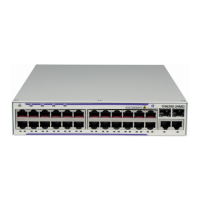MPLS and RSVP
7210 SAS M, T, X, R6, Mxp MPLS Configuration Guide Page 37
the far end T-PEs, not the local S-PE. Note that the ordering of the SAII:TAII in the PW Path ID
where static PWs are used should be consistent with the direction of signaling of the egress label
to a spoke-SDP forming that segment, if that label were signaled using T-LDP (in downstream
unsolicited mode). VCCV Ping will check the PW ID in the VCCV Ping echo request message
against the configured PW Path ID for the egress PW segment.
Figure 12 shows an example of how the PW Path IDs can be configured for a simple two-segment
MS-PW.
Figure 12: Example usage of PW Identifiers
Generic Associated Channel
MPLS-TP requires that all OAM traffic be carried in-band on both directions of an LSP or PW.
This is to ensure that OAM traffic always shares fate with user data traffic. This is achieved by
using an associated control channel on an LSP or PW, similar to that used today on PWs. This
creates a channel, which is used for OAM, protection switching protocols (for example, LSP
linear protection switching coordination), and other maintenance traffic, and is known as the
Generic Associated Channel (G-ACh).

